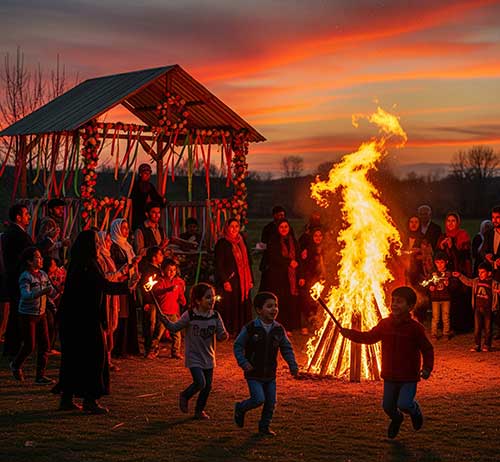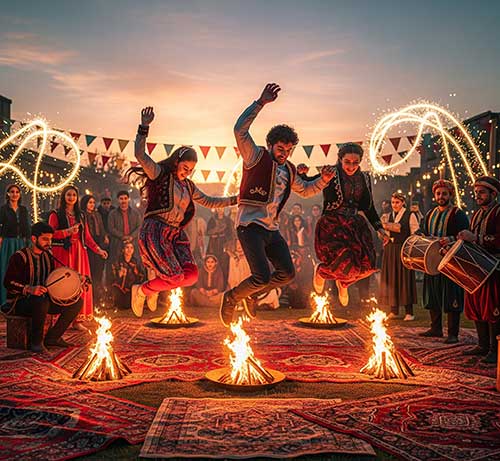Celebrations of Identity: Iranian Cultural Festivals and Traditions
7/4/2025
Iranian culture, with its deep historical roots and rich tapestry of customs, is home to a diverse range of festivals and traditions. These occasions are more than just holidays—they are reflections of values, worldviews, and a living connection to the past. Celebrated across generations and regions, Iranian festivals carry symbols of nature, light, spirituality, and national identity. While some trace back to Zoroastrian times, others reflect Islamic traditions, blending harmoniously into the social life of modern Iranians. This essay explores the most significant cultural occasions in Iran and their enduring meanings.
Nowruz – The Persian New Year
Arguably the most important and widely celebrated Iranian festival is Nowruz, meaning “New Day.” Nowruz marks the beginning of spring and the Persian calendar year, usually falling on March 20 or 21. Its roots are ancient, predating Islam, and go back to Zoroastrianism and perhaps even earlier agrarian beliefs tied to the rebirth of nature.
Nowruz celebrations last for about two weeks and begin with Khaneh-Tekani, or "house cleaning," symbolizing spiritual renewal. Families prepare a ceremonial table called Haft-Seen, which includes seven symbolic items starting with the Persian letter "S," such as Sabzeh (sprouted wheat), Seer (garlic), and Seeb (apple), each representing concepts like rebirth, health, and beauty.
On the last Wednesday before Nowruz, Iranians celebrate Chaharshanbe Suri, a fire festival in which people jump over bonfires, chanting, “Give me your red color, take away my sickly pallor,” asking the fire to cleanse and revitalize them. This ritual represents purification and letting go of the old year’s misfortunes.
The Nowruz period culminates with Sizdah Bedar, the 13th day of the new year, when families go outdoors for picnics. It’s believed that staying at home on the 13th brings bad luck, so people celebrate nature and community instead.
Yalda Night – The Longest Night of the Year
Shab-e Yalda, or Yalda Night, is celebrated on the winter solstice—the longest and darkest night of the year, usually around December 21. With roots in ancient Persia and Mithraic traditions, Yalda symbolizes the victory of light over darkness as days begin to lengthen.
Families gather to eat, read poetry (especially Hafez), and share fruits like watermelon and pomegranate—symbols of health, love, and light. Candles are lit, and elders tell stories to younger generations, turning the night into a celebration of warmth, hope, and resilience.
Mehregan – Festival of Friendship and Love
Mehregan, once as significant as Nowruz, is an ancient Iranian festival that honors Mithra, the Zoroastrian divinity of light, love, and covenant. It usually falls in early October, coinciding with the harvest season.
Traditionally, people would wear new clothes, set tables with fall fruits and sweets, and express gratitude and goodwill. In modern times, Mehregan is observed more modestly, though Zoroastrian communities and cultural organizations in Iran and abroad continue to celebrate it with rituals, music, and communal gatherings.
Sadeh – The Festival of Fire and Light

Celebrated 50 days before Nowruz, Sadeh is a Zoroastrian festival that honors fire and its role in life and creation. The word “Sadeh” means “hundred,” referring to the hundred days and nights left until spring.
In ancient times, massive bonfires were lit to honor fire as a symbol of truth and life. Although Sadeh is not widely practiced today outside of Zoroastrian circles, it remains a symbolic occasion, especially in cities like Yazd and Kerman, where traditional ceremonies are preserved.
Chaharshanbe Suri – The Fire Festival

Mentioned earlier as part of Nowruz traditions, Chaharshanbe Suri deserves its own space due to its popularity and cultural depth. Taking place on the eve of the last Wednesday of the year, the festival blends fire-worship rituals with social fun.
Fire jumping, firecrackers, and traditional songs fill the streets. The ritual not only wards off evil but also marks a symbolic cleansing before the New Year. It is one of the few remaining fire festivals from Iran’s pre-Islamic era that is still celebrated widely, despite occasional religious and governmental disapproval.
